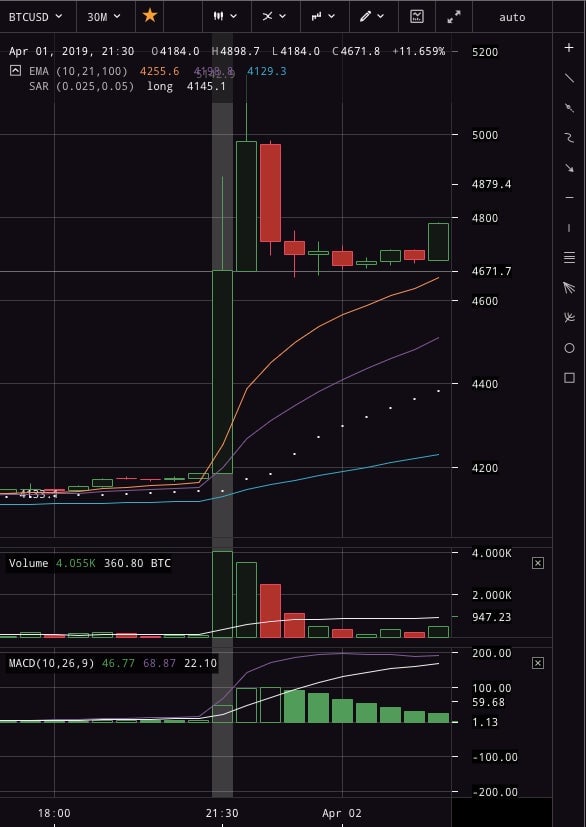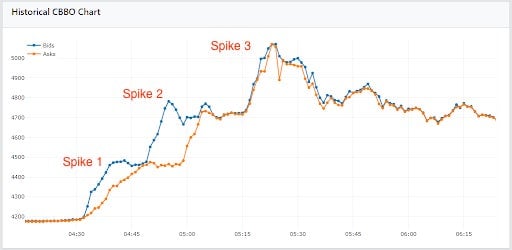What bitcoin’s 20% price surge says about the state of cryptocurrency
Bitcoin awoke from its slumber this week. The cryptocurrency’s price, which after reaching $20,000 in 2017 has languished near $4,000 for most of 2019, surged more than 20% on Tuesday (April 2), surpassing $5,000. The cause? A mystery trader—or group of traders—reportedly placed a series of large orders on major exchanges, including Coinbase, Kraken, and Bitstamp.


Bitcoin awoke from its slumber this week. The cryptocurrency’s price, which after reaching $20,000 in 2017 has languished near $4,000 for most of 2019, surged more than 20% on Tuesday (April 2), surpassing $5,000. The cause? A mystery trader—or group of traders—reportedly placed a series of large orders on major exchanges, including Coinbase, Kraken, and Bitstamp.
“There has been a single order that has been algorithmically-managed across these three venues, of around 20,000 [bitcoins],” said Oliver von Landsberg-Sadie, founder of BCB, a cryptocurrency financial services firm. “If you look at the volumes on each of those three exchanges – there were in-concert, synchronized, units of volume of around 7,000 [bitcoins] in an hour,” he explained to Reuters.
Indeed, order books reflect the surge, which occurred between 9:30 pm and 10:00 pm PT April 1. Here’s the view from Kraken:

At present, there is a circulating supply of 17.6 million bitcoins, so the mystery trader now controls a little more than 0.1% of the total in existence.
While that fraction appears tiny, it demonstrates the depth, or rather shallowness, of the bitcoin market. Bitcoin’s market cap is purportedly $92 billion, with a daily trading volume of $22 billion, according to CoinMarketCap, a price aggregator. But the actual volume is clearly much less than that. If CoinMarketCap’s data were accurate, a $100 million order should account for just 0.5% of bitcoin’s 24-hour trading volume. Assuming that trading is uniformly distributed, then $916 million of bitcoin orders are processed each hour. With that much trading, a concentrated $100 million order may be noticeable, but probably not this noticeable.
Dave Weisberger, CEO of CoinRoutes, a cryptocurrency smart order routing service, provided more insight. His company helps process trades for high net worth clients, carefully splitting orders across various exchanges to ensure clients receive the best prices possible.
This week’s bitcoin spike looks like either market manipulation or plainly ignorant trading, explained Weisberger. The 20,000-bitcoin order, he said, should be understood in three distinct phases.

The graphic above shows the spread between bids, the price that buyers are willing to pay (in blue), and asks, the price that sellers are willing to accept (in orange). For two 15-minute stretches this week, buyers were willing to pay substantially more than necessary—that’s why the lines diverge. As traders capitalized on this discrepancy, the market quickly returned to equilibrium, with bids and asks tracking closely together.
Weisberger suggested the first two spikes, the arbitrage opportunities, were created by the massive buy orders that were placed. However, there wasn’t a price discrepancy during the third spike which indicates that the final rise was due to bandwagoning buyers. Essentially, as other traders witnessed bitcoin’s rapid ascent, they tried to grab on for the ride.
Typically, when a trader places a huge purchase order, they try to avoid driving the price upward. Otherwise, they end up overpaying. Instead, they’ll gradually place a series of small orders, spaced out over a few days or weeks, to prevent this volatility. However, it’s possible that the mystery trader actually wanted to drive the bitcoin price higher, and thus, was willing to pay extra to do so. Weisberger suspects the $100 million order may have been the work of a crypto derivatives trader, who got caught on the wrong side of a futures bet. In order to make a derivatives bet pay off—or limit losses—the trader(s) may have intentionally ballooned bitcoin’s price in the spot market.
Of course, there were some other, wild ideas floated on Tuesday and Wednesday about bitcoin’s jump. One of the theories was that naive traders latched onto an April Fool’s article about the SEC approving a bitcoin ETF—a much-anticipated event that really could drive up the price of bitcoin. Bitcoin enthusiasts will have to keep holding their breath though.
In any other market, a 20% move would be a complete anomaly. Virtually every month though, bitcoin experiences a one-day change greater than 10%. In mid-December, the price rose 30%—from $3,200 to $4,200—in just four days. While few among us have $100 million laying around, this week’s spike should serve as a reminder: This remains an immature and explosive market. As quickly as bitcoin swoons, it can also soar.
🔑🔑🔑
Regulatory Watch
How the SEC approaches cryptocurrencies
There’s been a long-running debate about whether cryptocurrencies are legally considered “investment contracts.” This is a critical issue because it determines whether crypto-entrepreneurs, who have raised billions of dollars, must register the sale of digital tokens with the US Securities and Exchange Commission. Doing so would trigger disclosure requirements, which can make raising money harder but also helps protect investors from fraud. Projects which have already sold tokens could face penalties for failure to register with the agency.
While the SEC has repeatedly stated that crypto-entrepreneurs must respect federal securities laws, the crypto community has asked for greater clarity. Blockchain entrepreneurs often claim their networks—and tokens—are “decentralized,” so they argue, they aren’t subject to US securities laws. After many months, the SEC published staff guidance on Wednesday (April 3), which outlined the agency’s thinking about blockchain-based digital assets. In particular, the agency is giving special attention to the third prong of the Howey Test, the four-part tool used to determine whether something constitutes an “investment contract.”
The third prong refers to whether a venture relies on the managerial efforts of others. While crypto programmers often claim they’re loose collectives of open-source developers, the reality is most projects have some centralized management, which is responsible for maintaining the network and thereby ensuring the value of associated cryptocurrencies. The agency’s latest guidance casts strong doubt about the regulatory status of a few high-profile projects, including Ripple (XRP) and Tezos (XTZ). Each faces a class-action law suit alleging the sale of coins was an unregistered securities offering. Depending on the outcome of the cases, the projects, and their partners, could face fines or even be required to return money to investors.
Please send news, tips and prongs to [email protected]. Today’s Private Key was written by Matthew De Silva, and edited by Oliver Staley. All that we are not stares back at what we are.